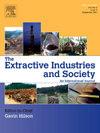拉丁美洲的锂开采模式:历史会重演吗?
IF 3.6
2区 社会学
Q2 ENVIRONMENTAL STUDIES
Extractive Industries and Society-An International Journal
Pub Date : 2024-12-07
DOI:10.1016/j.exis.2024.101581
引用次数: 0
摘要
锂是推动全球北方能源转型最需要的矿物之一。然而,世界上61.5%的自然保护区位于阿根廷、玻利维亚和智利。基于制度政治经济学方法,本文的第一个目标是在分析配置这些模式的行动者和制度的基础上,描述每个国家的锂开采模式。其次,本文评估了这三个国家是否采用了不同于(新)采掘模式的剥削模式,确定了最具决定性的制度和行为者配置。该分析确定了与智利和玻利维亚的(新)采掘模式部分不同的措施。在这些情况下,国家在改变游戏规则和逐步为基于锂的工业化议程铺平道路方面发挥了至关重要的作用。相比之下,阿根廷对跨国资本的服从程度更高。然而,由于依赖全球北方的需求,矿物开采似乎延续了初级出口模式,从而维持了中心-外围发展模式。尽管实施了供给侧战略,但电动汽车国内市场的缺乏对这三个国家有效推进其自身转型进程构成了结构性限制。本文章由计算机程序翻译,如有差异,请以英文原文为准。
Models of lithium exploitation in Latin America: Is history repeating itself?
Lithium is among the minerals most demanded for use in driving the energy transition of the global north. However, 61.5 % of world reserves are located in Argentina, Bolivia, and Chile. Based on an Institutional Political Economy approach, the first objective of this paper is to characterize the lithium exploitation models of each country based on analysis of the actors and regimes that configure them. Second, this paper evaluates whether the three countries are applying exploitation models distinct from the (neo)extractivist model, identifying the most decisive regimes and configurations of actors.
The analysis identifies measures that partially diverge from the (neo)extractivist model in Chile and Bolivia. In these cases, the State has played a crucial role in transforming the rules of the game and gradually paving the way for an industrialization agenda based on lithium. In contrast, Argentina shows a greater degree of subordination to transnational capital. Nevertheless, due to the reliance on demand from the Global North, mineral exploitation appears to perpetuate the primary-export model, thereby maintaining center-periphery development patterns. Despite the implementation of supply-side strategies, the absence of a domestic market for electric vehicles represents a structural limitation for these three countries in effectively advancing their own transition processes.
求助全文
通过发布文献求助,成功后即可免费获取论文全文。
去求助
来源期刊

Extractive Industries and Society-An International Journal
ENVIRONMENTAL STUDIES-
CiteScore
6.60
自引率
19.40%
发文量
135
 求助内容:
求助内容: 应助结果提醒方式:
应助结果提醒方式:


